 I attended the one-day Agile Tour London 2016 conference on the 21st October and thought I would write a few words on the event.
I attended the one-day Agile Tour London 2016 conference on the 21st October and thought I would write a few words on the event.
Agile events are always entertaining with a range of presentations and workshops from a varied set of industries, methodologies and people. I recommend Agile Tour London as a great opportunity for collaboration and sharing of experience to learn from others on the same journey.
It’s said that a wise person learns from his mistakes. A wiser one learns from others’ mistakes. But the wisest person of all learns from others’ successes. (John C Maxwell)
I always look forward to attending Agile Tour London as each year I get to spend the day with two great people who I used to work alongside. As well as listening to presentations and taking part in workshops we have the opportunity to talk over lunch about the industry, our roles and the changes happening. We also compare notes on the sessions we attend and share information and techniques.

The program was full this year offering five different choices for each of the six forty-five minute sessions. To challenge myself this year I avoided all of the presentations and opted instead to perform three double-session workshops. My reasoning was that I would gain most from the day in this way and would end up with the most useful and actionable outputs.
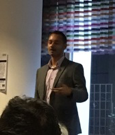
ATL2016 started with development coach Antony Marcano’s keynote “Don’t put me in a box”. Antony spoke about avoiding using job titles as labels for people and that limiting people by their perceived role is a massive waste. The keynote was slightly rambling and fairly interesting but certainly not an empowering ground-breaking call to action which I may personally have hoped for.
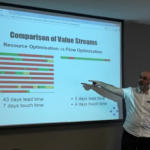 The first workshop that I attended was “Practical Value Stream Mapping for Flow Optimisation” with development team lead Joe Schemetzer. Joe works at UBS and also organises the Extreme Tuesday Club for extreme programmers (XP). In the first half of the workshop we explored lead time, touch time and total time along with the cost of delay. The second half was more practical with each team creating an entire workflow for one member’s day job. I enjoyed this workshop and thought the specifics of the method were very useful. The steps we followed were:
The first workshop that I attended was “Practical Value Stream Mapping for Flow Optimisation” with development team lead Joe Schemetzer. Joe works at UBS and also organises the Extreme Tuesday Club for extreme programmers (XP). In the first half of the workshop we explored lead time, touch time and total time along with the cost of delay. The second half was more practical with each team creating an entire workflow for one member’s day job. I enjoyed this workshop and thought the specifics of the method were very useful. The steps we followed were:
- Measure
- Map the value stream
- Plan and update the value stream
- Perform small, incremental experiments (Toyota improvement kata – see next workshop)
The content was based on some of my favourite books including Principles of Product Development Flow, The Phoenix Project, Slack, The Toyota Way, Value Stream Mapping and Specification by Example.
I thought this workshop was a great start to the day and hopefully a fair portent… or so I thought…
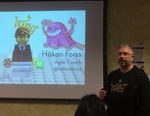 After lunch I went to the “Toyota Kata Puzzle Experience” workshop with Agile author Hakan Forss who works for game publisher King (Candy Crush, Bubble Witch, Paradise Bay etc.). Hakan’s workshop was very interactive with each team using the Toyota Improvement Kata to improve the speed at which they could put together a puzzle. The improvement kata is based on four steps:
After lunch I went to the “Toyota Kata Puzzle Experience” workshop with Agile author Hakan Forss who works for game publisher King (Candy Crush, Bubble Witch, Paradise Bay etc.). Hakan’s workshop was very interactive with each team using the Toyota Improvement Kata to improve the speed at which they could put together a puzzle. The improvement kata is based on four steps:
- Understand the challenge
- Grasp the current condition
- Establish your next target condition
- Experiment toward the target condition
In this workshop our challenge was to build the puzzle in 15 seconds (step 1). Our team’s first attempt at putting the puzzle together took 45 seconds (step 2). Our target for the next condition was 40 seconds (step 3) with our experiment being to split the puzzle areas among the team (step 4). We achieved 38 seconds so considered the first experiment a success. We then iterated through a series of experiments to continue improving upon our time.
The workshop was based on another couple of great books – Toyota Kata and Managing Flow.
The last workshop of the day was “Lean Startu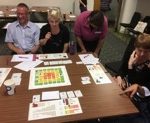 p game” with Frederik Vannieuwenhuyse where we used the board game Playing Lean to learn more about innovation and Lean Startup. I love using the Playing Lean game for training Lean Startup and was keen to see someone else teaching to see what I could learn. Our team of three competed with three other teams to develop an idea into a market winning product. It was great fun to see our company develop and product evolve over the ninety minutes until we achieved market fit and won the game.
p game” with Frederik Vannieuwenhuyse where we used the board game Playing Lean to learn more about innovation and Lean Startup. I love using the Playing Lean game for training Lean Startup and was keen to see someone else teaching to see what I could learn. Our team of three competed with three other teams to develop an idea into a market winning product. It was great fun to see our company develop and product evolve over the ninety minutes until we achieved market fit and won the game.
Frederik clearly demonstrated the Lean Startup principles via the Playing Lean board game and I felt everyone left with a better understanding. As a hint, try to avoid the grumpy cat experiment card – very annoying.
Playing Lean is based on the books Lean Startup, Running Lean and The Startup Owners Manual.
After three intensive workshops I enjoyed networking during the farewell drinks.
I look forward to seeing many of you at next year’s conference.

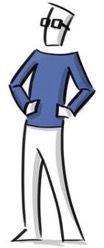 My second Front Row Agile post has just been published which is great to see.
My second Front Row Agile post has just been published which is great to see. I attended the one-day Agile Tour London 2016 conference on the 21st October and thought I would write a few words on the event.
I attended the one-day Agile Tour London 2016 conference on the 21st October and thought I would write a few words on the event.




